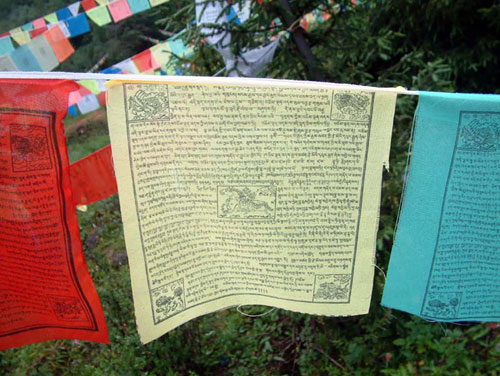Wind-Horse Flag
Updated: 2007-07-24 08:38
Legends about prayer flags
There is a legend about the creation of prayer flag: Once a monk obtained an important scripture from India, but unfortunately got it wet in the river on his way back. Having laid the scripture open to dry in the sunshine, the monk then sat and meditated with his legs crossed under a big tree.
Suddenly, gongs and horns rang out and the sound of Sanskrit reverberated in the air. As the gentle breeze was stroking his face under the blue sky, the monk felt utterly refreshed and all of a sudden, seemed to understand everything in the universe completely. Slightly opening his eyes, the monk found the scripture had been blown all over the sky, the tree and the river. He let out a loud laugh and disappeared in the distance, leaving behind the flying scripture and the bursts of the sound of Sanskrit.
From then on, the Tibetans began to print lines of the scripture on cloth or paper and hang them in the air in commemoration of the monk's attained enlightenment and as a tribute to the Buddhist scripture.
A brief introduction to prayer flags
**Material
The most commonly used material of prayer flags is cloth, but there are also
flags made from hemp, silk and handmade paper. Prayer flags come in various
shapes and sizes, but in most cases, they are square or rectangular in shape and
have a width ranging from 10 to 60 centimeters. Sometimes, a prayer flag can be
as small as a narrow stripe while a large one can extend to cover a whole roll
of cotton cloth. They are either attached to a rope or thrown out into the air
at random. When the wild wind blows, pieces or clusters of prayer flags flutter
against the blue sky, the snow mountains and the bright shining lakes, signaling
the upward spirit and people's positive attitude toward life.
 | 1 | 2 | 3 | 4 |  |


